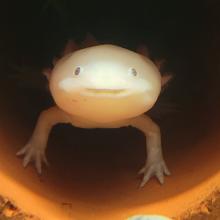Ambystoma mexicanum

Conservation Status:
Critically endangered
Range:
Central Mexico
Habitat:
Deep lakes
Axolotls are a fresh water aquatic animal that formerly existed in Lake Chalco until it was drained. Now they can only be found in Lake Xochimilco of Mexico City. They are top predators requiring deep lakes and plenty of plant life for reproduction.
Axolotls possess external gills to help in the process of respiration; however these gills are a characteristic that is usually found in the larval form of most salamanders. They have semi-developed limbs and teeth which contribute to the predatorial dominance in their habitats. Axolotls’ life spans can reach up to 15 years on a diet of mollusks, worms, insect larvae, crustaceans and some fish. They will snap and suck their prey into their stomachs whole.
Axolotls are neotenic, meaning that they reproduce in their larval stage, and never undergo metamorphosis in the adult salamander stage. This trait is sometimes exhibited in other salamanders when resources are scarce, but is the natural life cycle for the axolotl. Breeding occurs once a year from March to June. Up to 400 eggs are laid in a mucous matrix and protected for 3-4 weeks. Hatchlings are immediately independent and will consume algae and plankton.
When Axolotls are injured, instead of developing scar tissue, it reverts back to stem cells, allowing them to re-grow lost limbs. This species exists in naturally in only one lake in the entire world, which receives pollution and runoff from the city surrounding it. Axolotls also suffer from the introduction of large fish into their lake habitat. Axolotls are listed as critically endangered on the IUCN Red list, but there may come a time when this species is completely extirpated, no longer existing in its native range.
